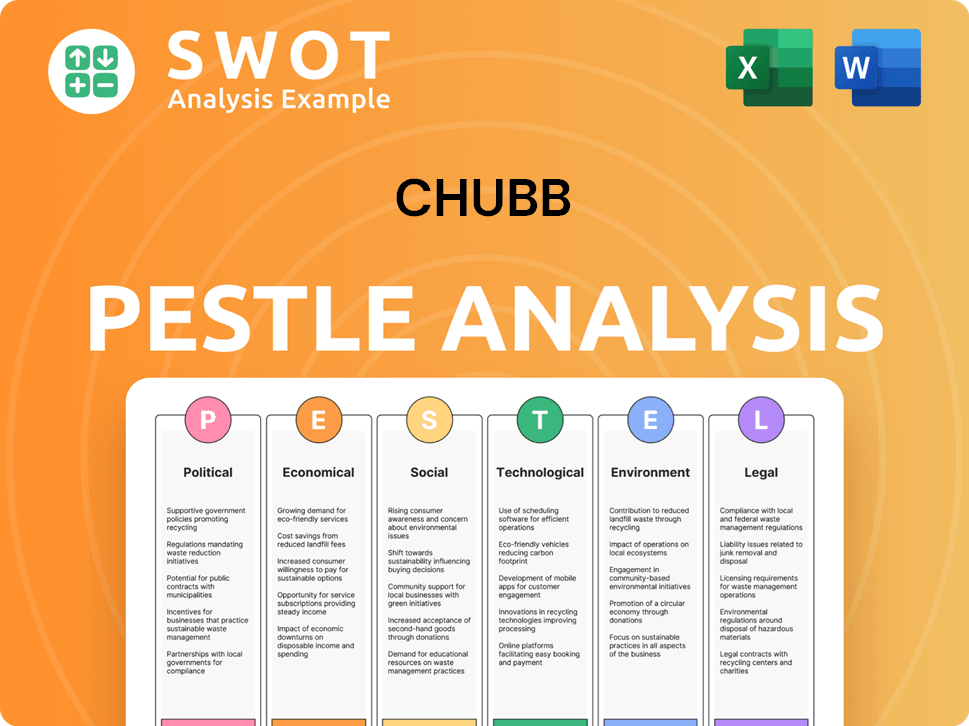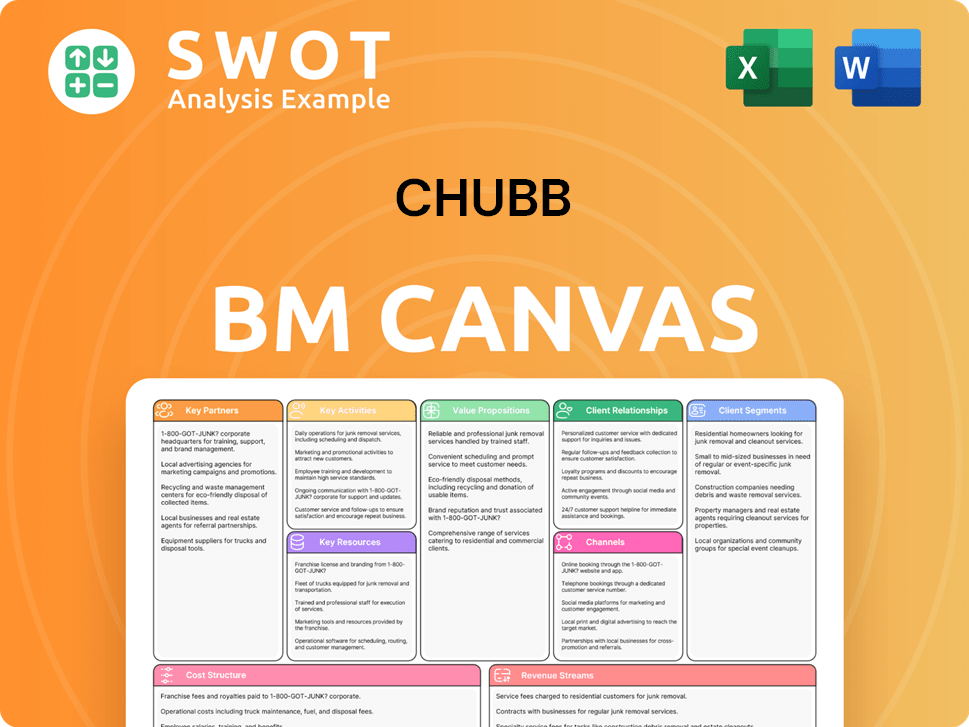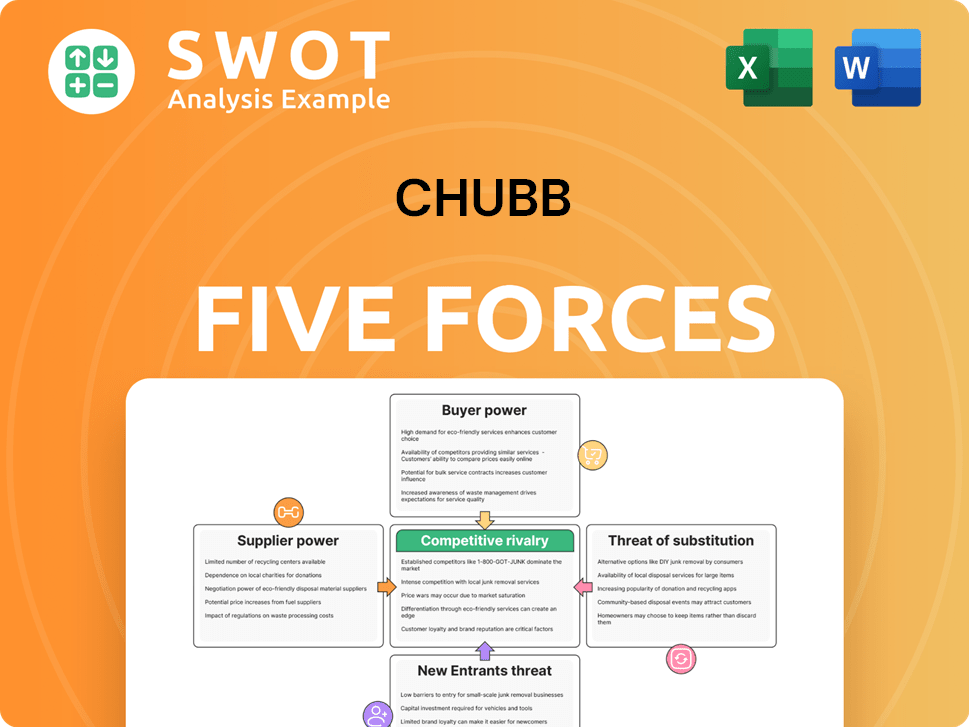Chubb Bundle
How Does Chubb Thrive in the Insurance World?
Chubb, a global leader in the insurance industry, consistently demonstrates its financial prowess, reporting a record net income in 2024. As a leading Chubb SWOT Analysis reveals, the company's expansive global operations, spanning 54 countries, underscore its critical role in managing risks for a wide array of clients. Its strong performance and strategic adaptability make it a compelling case study for investors and industry watchers alike.

This deep dive into the Chubb company will explore its multifaceted operations, from its diverse product offerings, including property and casualty insurance, to its strategic moves in a dynamic market. Understanding the Chubb insurance model is key to grasping its sustained profitability and future prospects, especially considering recent challenges like the California wildfires and the company's commitment to customer service. Whether you're researching Chubb auto insurance reviews or looking into Chubb insurance for high-value homes, this analysis provides essential insights.
What Are the Key Operations Driving Chubb’s Success?
Chubb creates value by offering a wide range of insurance products and services. It protects against various risks for a broad spectrum of customers. Its core offerings include commercial and personal property and casualty (P&C) insurance, personal accident and supplemental health (A&H) insurance, reinsurance, and life insurance.
Chubb serves multinational corporations, small businesses, affluent and high-net-worth individuals, and those seeking personal accident and health coverage. Its operational processes are multifaceted, emphasizing underwriting excellence and a disciplined approach to risk selection. This approach contributed to a P&C combined ratio of 85.7% in Q4 2024.
The company's claims handling expertise is a key differentiator, with claims teams operating in over 200 countries. Chubb's distribution networks are extensive, using independent agents, brokers, and direct-to-consumer partnerships. This broad reach allows access to hundreds of millions of existing and potential customers globally.
Chubb offers a diverse portfolio of insurance products. These include commercial and personal property and casualty insurance, personal accident and supplemental health insurance, reinsurance, and life insurance. This variety allows the company to cater to a wide range of customer needs and risk profiles.
The company serves several key customer segments. These include multinational corporations, small businesses, affluent and high-net-worth individuals, and individuals seeking personal accident and health coverage. This diversified customer base helps to stabilize the company's revenue streams.
Chubb utilizes a broad network of distribution channels. These include independent agents and brokers, exclusive life and health agents, bancassurance, mobilassurance, and direct-to-consumer partnerships. This multi-channel approach ensures broad market access and customer convenience.
With operations in 54 countries and territories, Chubb has a significant global footprint. The company employs approximately 43,000 people worldwide. This global presence allows Chubb to serve diverse markets and adapt to local needs effectively.
Chubb's operational uniqueness lies in its combination of global scale with local expertise, strong underwriting discipline, and a diverse product portfolio. This allows the company to navigate various market cycles. These core capabilities translate into customer benefits through tailored solutions, reliable claims service, and financial security, differentiating Chubb in the competitive insurance landscape. Learn more about the company in this detailed analysis of Chubb insurance.
- Underwriting Excellence: A disciplined approach to risk selection and pricing.
- Claims Handling: Expertise with claims teams in over 200 countries.
- Distribution Network: Extensive use of independent agents, brokers, and direct-to-consumer partnerships.
- Global Presence: Operations in 54 countries and territories.
Chubb SWOT Analysis
- Complete SWOT Breakdown
- Fully Customizable
- Editable in Excel & Word
- Professional Formatting
- Investor-Ready Format

How Does Chubb Make Money?
The primary revenue streams for the insurance provider, Chubb, are diverse, encompassing property and casualty (P&C) underwriting, investment income, and international life insurance. This multi-faceted approach allows the company to maintain financial stability and capitalize on various market opportunities. Understanding these revenue sources is crucial for assessing the company's overall financial health and strategic direction.
Chubb's monetization strategies are built upon a foundation of a diverse product portfolio, disciplined underwriting practices, and strategic investments. The company also leverages a broad distribution network to optimize sales channels and reach a wide customer base. This comprehensive approach supports its ability to generate consistent revenue and maintain a strong market position.
In 2024, Chubb reported a total revenue of $56.11 billion, which further increased to $56.69 billion for the twelve months ending March 31, 2025. This demonstrates the company's consistent ability to generate significant income.
P&C underwriting is a core business for Chubb, contributing significantly to its revenue. In 2024, the company wrote $55.4 billion in P&C gross written premiums and generated a record P&C underwriting income of $5.9 billion, up 7.1% from the previous year. This growth highlights the company's strong performance in this segment. Furthermore, global P&C net premiums written, excluding agriculture, increased by 9.6% in 2024. This growth was supported by an 8.7% increase in commercial lines and a 12.1% increase in consumer insurance. In Q1 2025, consolidated net premiums written were $12.6 billion, reflecting a 5.7% increase in constant dollars.
- Disciplined underwriting practices are key to ensuring profitability in this segment.
- Chubb offers a wide range of P&C products to cater to various customer segments.
- The company focuses on risk management to mitigate potential losses.
Investment income is another significant revenue stream for Chubb. Adjusted net investment income grew by 19.3% to $6.4 billion in 2024, reaching a record level. This growth reflects the company's effective management of its investment portfolio. For Q1 2025, adjusted net investment income was $1.7 billion, up 12.7%. This demonstrates the company's ability to generate substantial returns from its investments.
- Chubb's investment strategy focuses on maximizing returns while managing risk.
- The company's investment portfolio includes a diverse range of assets.
- Effective asset allocation and management are crucial for generating investment income.
Chubb's international life insurance business, particularly in Asia, is a growing source of revenue. Life insurance premiums were up 18.5% in constant dollars to $6.3 billion in 2024, with segment income reaching a record $1.1 billion. In Q1 2025, Life Insurance net premiums written increased by 10.3% in constant dollars, and segment income was up 15.7% in constant dollars. The acquisition of Liberty Mutual's business in Thailand and Vietnam contributed $275 million in premiums, indicating strategic expansion. This segment's growth highlights Chubb's successful expansion into international markets.
- Chubb focuses on expanding its life insurance offerings in key Asian markets.
- The company's international life insurance business contributes significantly to its overall revenue growth.
- Strategic acquisitions and partnerships support the company's expansion efforts.
Chubb's monetization strategies are multifaceted. These include a diverse product portfolio, disciplined underwriting, and strategic investments. The company also utilizes a broad distribution network, including independent agents, brokers, and direct marketing, to optimize sales channels. For more insights into the company's strategic approach, consider reading about the Growth Strategy of Chubb.
- A diverse product portfolio caters to various customer segments, including those seeking Chubb insurance for high-value homes and commercial insurance coverage.
- Disciplined underwriting ensures profitability by carefully assessing and managing risks.
- Strategic investments are made to maximize returns on capital.
- A broad distribution network optimizes sales channels.
Chubb PESTLE Analysis
- Covers All 6 PESTLE Categories
- No Research Needed – Save Hours of Work
- Built by Experts, Trusted by Consultants
- Instant Download, Ready to Use
- 100% Editable, Fully Customizable

Which Strategic Decisions Have Shaped Chubb’s Business Model?
The journey of the Chubb company has been marked by significant milestones and strategic moves that have shaped its operational and financial performance. A pivotal moment was the acquisition of the original Chubb Corporation by ACE Limited in 2016, leading to the combined entity adopting the Chubb name. This strategic move expanded Chubb's global footprint and diversified its product offerings, making it the world's largest publicly traded property and casualty insurer.
In recent years, Chubb has strategically invested in technology, allocating approximately $1.1 to $1.2 billion annually to modernize legacy systems and enhance AI-driven analytics. This focus has helped maintain a low expense ratio in the P&C sector and improve processing capabilities. Another key strategic move is its geographic expansion, particularly in high-growth emerging markets like Asia and Latin America. The acquisition of Liberty Mutual's operations in Thailand and Vietnam in Q1 2025 exemplifies this strategy.
Chubb has also navigated significant operational and market challenges. For instance, the company faced substantial catastrophe losses from the California wildfires in Q1 2025, with an estimated $1.5 billion net pre-tax loss. In response, Chubb has reduced its exposure in wildfire-prone areas by over 50%, reflecting a proactive approach to risk management. You can learn more about the company's growth strategy in this article: Growth Strategy of Chubb.
The acquisition by ACE Limited in 2016, which led to the combined entity adopting the Chubb name, was a pivotal event. This transformed Chubb into the world's largest publicly traded property and casualty insurer. This strategic move significantly expanded Chubb's global footprint and diversified its product offerings.
Chubb invests heavily in technology, allocating $1.1 to $1.2 billion annually for modernization and AI-driven analytics. Geographic expansion, especially in emerging markets like Asia and Latin America, is another key strategy. The acquisition of Liberty Mutual's operations in Thailand and Vietnam in Q1 2025 is a prime example.
Chubb's global presence, strong brand reputation, and diverse product portfolio are fundamental strengths. Underwriting discipline leads to a superior combined ratio compared to industry peers. Financial strength, with AA ratings from Standard & Poor's and A++ from A.M. Best, instills confidence.
In Q1 2025, Chubb faced a $1.5 billion net pre-tax loss due to California wildfires. The acquisition in Thailand and Vietnam added $275 million in annual premiums. Chubb has reduced its exposure in wildfire-prone areas by over 50%.
Chubb's competitive edge stems from its global presence, strong brand, and diverse product offerings. The company's underwriting discipline consistently yields a superior combined ratio compared to competitors. Financial strength, backed by AA ratings from Standard & Poor's and A++ from A.M. Best, further enhances its position.
- Strong brand reputation
- Diverse product portfolio
- Underwriting discipline
- Financial strength
Chubb Business Model Canvas
- Complete 9-Block Business Model Canvas
- Effortlessly Communicate Your Business Strategy
- Investor-Ready BMC Format
- 100% Editable and Customizable
- Clear and Structured Layout

How Is Chubb Positioning Itself for Continued Success?
As the world's largest publicly traded property and casualty insurance company, Chubb maintains a strong industry position. Operating in 54 countries and territories, Chubb has a well-balanced global presence, with about 60% of its premiums originating in North America and the remaining 40% spread across Asia, the U.K., Europe, and Latin America. Its diverse product portfolio, solid brand reputation, and consistent underwriting profitability contribute to customer loyalty and competitive standing.
Despite its robust position, Chubb faces several risks. Catastrophe volatility, as demonstrated by significant losses from the California wildfires in Q1 2025, presents a substantial risk due to the unpredictable nature of weather-related events. Economic uncertainties, such as increased recession probabilities and inflation, could curb demand for insurance and slow premium growth. Furthermore, U.S. trade policies, including tariffs and geopolitical tensions, introduce uncertainty for global operations. Regulatory changes in various jurisdictions also pose a continuous challenge for the company's global business. For further insights, consider exploring the Marketing Strategy of Chubb.
Chubb is the world's largest publicly traded property and casualty insurance company. It has a significant global presence, with operations in 54 countries and territories. Its strong brand reputation and diverse product portfolio contribute to its competitive standing.
Catastrophe volatility, like the California wildfires, poses a significant risk. Economic uncertainties, such as recession probabilities and inflation, could affect demand. U.S. trade policies and regulatory changes also introduce uncertainties for the company.
Chubb plans to focus on middle market and small business opportunities. It is investing in technology, with an annual spend of $1.1-1.2 billion. Geographic expansion, especially in Asia, is a key strategy. The company aims for double-digit earnings and EPS growth.
Chubb is committed to shareholder returns through share repurchases and dividends. The company approved its 32nd consecutive annual dividend increase in May 2025. It focuses on disciplined risk management and strategic growth initiatives to capitalize on global insurance market opportunities.
Chubb is actively pursuing strategic initiatives to sustain and expand revenue generation. The company focuses on middle market and small business opportunities. Technology investments, with an annual spend of $1.1-1.2 billion, aim to enhance digital capabilities. Geographic expansion, particularly in Asia, is a key priority. Leadership is optimistic about achieving double-digit earnings and EPS growth.
- Disciplined investment approach.
- Focus on digital capabilities to improve efficiency.
- Emphasis on geographic expansion, particularly in Asia.
- Commitment to shareholder returns through share repurchases and dividends.
Chubb Porter's Five Forces Analysis
- Covers All 5 Competitive Forces in Detail
- Structured for Consultants, Students, and Founders
- 100% Editable in Microsoft Word & Excel
- Instant Digital Download – Use Immediately
- Compatible with Mac & PC – Fully Unlocked

Related Blogs
- What are Mission Vision & Core Values of Chubb Company?
- What is Competitive Landscape of Chubb Company?
- What is Growth Strategy and Future Prospects of Chubb Company?
- What is Sales and Marketing Strategy of Chubb Company?
- What is Brief History of Chubb Company?
- Who Owns Chubb Company?
- What is Customer Demographics and Target Market of Chubb Company?
Disclaimer
All information, articles, and product details provided on this website are for general informational and educational purposes only. We do not claim any ownership over, nor do we intend to infringe upon, any trademarks, copyrights, logos, brand names, or other intellectual property mentioned or depicted on this site. Such intellectual property remains the property of its respective owners, and any references here are made solely for identification or informational purposes, without implying any affiliation, endorsement, or partnership.
We make no representations or warranties, express or implied, regarding the accuracy, completeness, or suitability of any content or products presented. Nothing on this website should be construed as legal, tax, investment, financial, medical, or other professional advice. In addition, no part of this site—including articles or product references—constitutes a solicitation, recommendation, endorsement, advertisement, or offer to buy or sell any securities, franchises, or other financial instruments, particularly in jurisdictions where such activity would be unlawful.
All content is of a general nature and may not address the specific circumstances of any individual or entity. It is not a substitute for professional advice or services. Any actions you take based on the information provided here are strictly at your own risk. You accept full responsibility for any decisions or outcomes arising from your use of this website and agree to release us from any liability in connection with your use of, or reliance upon, the content or products found herein.